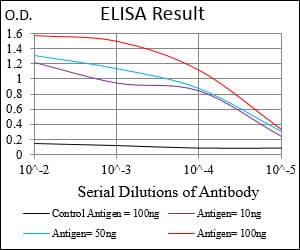

| WB | 咨询技术 | Human,Mouse,Rat |
| IF | 咨询技术 | Human,Mouse,Rat |
| IHC | 咨询技术 | Human,Mouse,Rat |
| ICC | 技术咨询 | Human,Mouse,Rat |
| FCM | 1/200 - 1/400 | Human,Mouse,Rat |
| Elisa | 1/10000 | Human,Mouse,Rat |
| Aliases | NAP; P14L; PP8304; C20orf33; dJ633O20.1 |
| Entrez GeneID | 56259 |
| clone | 2H10F11 |
| WB Predicted band size | 65.2kDa |
| Host/Isotype | Mouse IgG2a |
| Antibody Type | Primary antibody |
| Storage | Store at 4°C short term. Aliquot and store at -20°C long term. Avoid freeze/thaw cycles. |
| Species Reactivity | Human |
| Immunogen | Purified recombinant fragment of human CTNNBL1 (AA: 390-557) expressed in E. Coli. |
| Formulation | Purified antibody in PBS with 0.05% sodium azide. |
+ +
以下是3篇关于CTNNBL1抗体的参考文献概览:
---
1. **标题**: *CTNNBL1 facilitates the association of HIV-1 envelope with host Gag-Pol during virus assembly*
**作者**: Li et al. (2018)
**摘要**: 本研究利用CTNNBL1特异性抗体进行免疫共沉淀实验,揭示了CTNNBL1在HIV-1病毒组装过程中通过介导病毒包膜蛋白与宿主Gag-Pol复合物的相互作用促进病毒释放的机制。
---
2. **标题**: *CTNNBL1 interacts with dynein motor complex and participates in adipocyte differentiation*
**作者**: Moreno-Corona et al. (2020)
**摘要**: 通过Western blot和免疫荧光技术,作者发现CTNNBL1抗体检测到该蛋白在脂肪细胞分化中与动力蛋白复合物相互作用,提示其可能通过调控囊泡运输影响脂质代谢相关疾病。
---
3. **标题**: *A novel splice variant of CTNNBL1 promotes tumor metastasis through activating Wnt/β-catenin pathway*
**作者**: Wang et al. (2021)
**摘要**: 研究使用CTNNBL1抗体进行免疫组化分析,发现其剪切变体在结直肠癌中高表达,并通过激活Wnt通路促进肿瘤转移,为癌症预后提供了潜在标志物。
---
这些文献展示了CTNNBL1抗体在病毒学、代谢疾病及癌症研究中的关键应用。如需具体文献链接或补充更多研究,可进一步提供信息。
**Background of CTNNBL1 Antibody**
CTNNBL1 (Catenin Beta Like 1) is a nuclear protein involved in diverse cellular processes, including pre-mRNA splicing, protein-protein interactions, and regulatory pathways. Although structurally resembling β-catenin, it does not directly participate in Wnt signaling. Instead, CTNNBL1 interacts with components of the spliceosome machinery (e.g., CDC5L) and plays a role in mRNA processing. It also associates with APOBEC3G, influencing antiviral activity against HIV-1. and participates in nonsense-mediated mRNA decay (NMD) by interacting with SMG1 and UPF1.
CTNNBL1 antibodies are essential tools for studying its expression, localization, and molecular interactions. They are widely used in techniques like Western blotting, immunofluorescence, and immunoprecipitation to explore its regulatory roles in development, cancer, and immune response. Dysregulation of CTNNBL1 has been linked to diseases such as colorectal cancer, neurodevelopmental disorders, and metabolic syndromes.
Research using CTNNBL1 antibodies has highlighted its tissue-specific expression and post-translational modifications, suggesting context-dependent functions. However, its precise mechanisms remain partially unclear. These antibodies continue to advance investigations into how CTNNBL1 balances splicing accuracy, gene expression, and cellular homeostasis, offering insights into therapeutic targets for related pathologies.
×